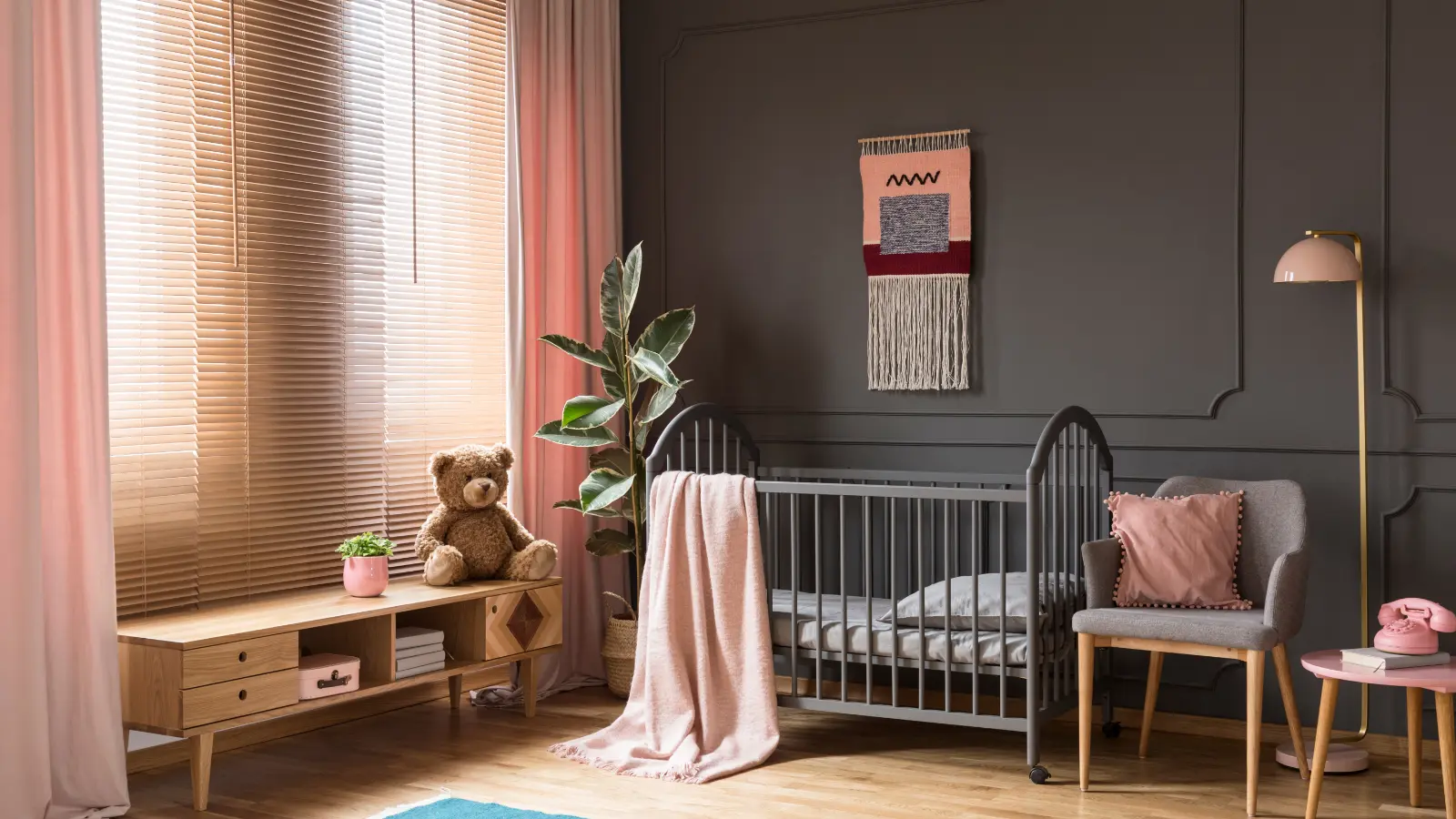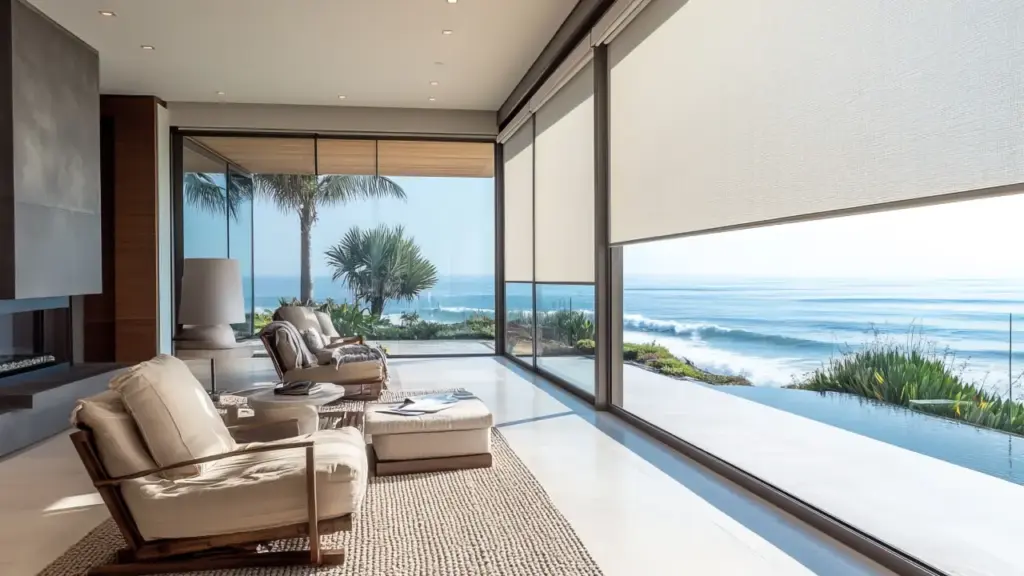Finding the Best Window Treatments for a Nursery

Few things are more exciting than bringing a new baby into your home. New blinds are exciting, too, and there’s no reason you can’t have both.
Not all window treatments work well in a nursery. Corded blinds aren’t the best choice for the room you’re busy decorating with kiddie decals.
But the right window treatments can help you create a warm and safe sanctuary for your baby and a stylish retreat for yourself.
Choosing the Right Window Treatments
1. Blackout Shades for Peaceful Sleep
Blackout shades effectively block out light and provide an ideal environment for your baby to nap during the day. They also come in handy for those early morning wake-up calls when the sun peeks over the horizon.
As a bonus, blackout shades dampen sound. So, your baby won’t have sleep interrupted by that pesky neighborhood dog or early morning traffic.
Look for high-quality cordless blackout shades, which are much safer for children than corded varieties. And if you think they have to be dark and drab, think again — blackout shades are available in a riot of colors and patterns to fit your nursery’s theme.
Consider using blackout liners with your existing curtains or blinds for a more budget-friendly option. Just ensure the liners are well-fitted to block out light.
2. Cellular Shades for Warmth & Energy Efficiency
Cellular shades, also known as honeycomb shades, are an excellent choice for nurseries because of their insulating properties. These shades have pockets, or “cells,” that trap air and form a barrier between the window and the room. This keeps the nursery toasty during the winter and comfortably cool during the summer.
Cellular shades can significantly reduce your energy bills. Like blackout shades, they have sound-dampening properties for better sleep, too.
Cordless options make them safe for children. And with a wide range of colors and styles, you can easily find the perfect match for your nursery.
3. Motorized Shades for Safety & Convenience
Motorized shades are the king of the hill when it comes to safety and convenience. You can adjust the light levels with the touch of a button or even a voice command. Their ultra-quiet operation ensures your baby’s nap won’t be disturbed, and you can continue to binge-watch your favorite show.
Cordless motorized shades remove the risk of accidents and strangulation. They’re also ideal for hard-to-reach windows or if you have mobility issues. Like all shades, they give you an almost unlimited menu of color and pattern choices.
4. Sheer Curtains for Soft Natural Lighting
These delicate, translucent window treatments filter daylight, reducing glare and heat while allowing a serene luminosity to infuse the nursery. The diffused light can make the nursery feel more expansive and open.
Sheer curtains come in assorted colors, patterns, and designs, so you can undoubtedly find something to match your nursery’s theme. For a safer option, go cordless or use breakaway cords.
Sheer curtains don’t block out light entirely, so you might want to pair them with blackout shades or liners for those midday naps and early bedtimes.
5. Sheer Shades for a Gentle Glow
Sheer shades balance privacy and light; their fabric diffuses strong sunlight, reducing glare and harsh shadows while maintaining a bright, airy atmosphere for exploring and learning.
As with sheer curtains, consider pairing them with blackout liners or shades if you need complete darkness. And install cordless versions for safety.
6. Roman Shades for Soft Elegance
Roman shades elevate the room’s aesthetic with their smooth, clean lines and sophisticated drape. They’re among the best window treatments blocking light.
Cordless versions are 100% child-safe; shades with more durable fabrics can be thrown in the wash.
As with all shades, Roman shades are available in various fabrics, colors, and patterns, from light and airy to cozy and dramatic.
7. Horizontal Blinds for Light Control
Horizontal blinds are a tried-and-true option for nurseries, providing optimal control over light and privacy. Their slats can be tilted, raised, or lowered to adjust the light entering the room.
This feature is a godsend when you want to let in natural light for playtime but need to dim the room for naps. Plus, when fully closed, horizontal blinds offer excellent privacy for feeding time.
For safety, opt for cordless versions or those with breakaway cords.
Horizontal blinds come in many colors, materials, and finishes — so finding the right match for your nursery decor is a breeze. Couple them with curtains or drapes for added insulation and light blocking.
8. Valances & Cornices for a Touch of Sophistication
A valance is a short decorative drapery hanging from the top of your window, hiding the hardware of blinds or shades. A cornice is a hard-top window treatment, usually made of wood, that adds architectural interest.
These decorative elements mirror any style, from playful and whimsical to elegant and classic. They’re available in a smorgasbord of fabrics, colors, and patterns to perfectly match your nursery’s theme.
While they don’t provide light control or privacy on their own, valances and cornices pair beautifully with other window treatments — such as cellular or Roman blinds — for a cohesive, polished look.
Since they don’t have cords, they pose no risk to children.
Ensuring Child Safety
- Opt for cordless window treatments to eliminate the risk of entanglement. Cordless blinds, shades, and curtains are readily available.
- If you have window treatments with cords, install safety devices such as cord cleats and cord stops to keep lines out of your child’s reach.
- Place cribs and other nursery furniture away from windows to prevent toddlers from climbing and reaching the window treatments.
- Consider installing window guards or grills for added safety.
- Regularly check your window treatments and cords for any signs of wear and tear. Replace them if necessary.
Other Considerations
- Choose colors and patterns that complement the nursery’s theme and create a soothing atmosphere.
- Ensure that your window treatments are easy to clean and maintain.
- Test the window treatment’s light and privacy control before you buy to see if it meets your needs.
- Install window treatments with insulating properties to save on energy bills. Cellular shades may make you eligible for a tax credit.
- Measure your windows accurately before purchasing any window treatment. If you’re not sure how to do this, call a professional.
Who Sells Window Treatments for Nurseries?
We do! We’re Aero Shade, LA’s most trusted window treatment company (and one of the oldest). And we love kids almost as much as we love window treatments.
Call us for a free estimate, or stop by our Los Angeles showroom to see and test working models of our products. We carry everything under the sun, and we’ll customize any window treatment to fit exactly and look great. Call us today!
FAQs: More about Nursery Window Treatments
Q: Are blackout curtains necessary for a nursery?
No, but they can create an ideal sleep environment for your baby during the day.
Q: What’s the safest window treatment for a nursery?
Cordless window treatments, like cordless blinds or shades, are the safest option for a nursery.
Q: How do I choose the right color for window treatments?
Select a color that complements the nursery’s decor for a soothing atmosphere. Soft pastels or neutrals are popular choices.
Q: What’s the best way to clean nursery window treatments?
Machine-washable curtains and wipe-clean blinds are the easiest to maintain in a nursery.
Q: Can I combine different types of window treatments in the nursery?
Layering window treatments adds depth and texture to your decor and provides flexible light control. For example, you can pair sheer curtains with blackout shades.
Q: Are there any window treatments that can help with energy efficiency?
Cellular shades have excellent insulating properties. They can help keep the nursery warm in winter and cool in summer.
Q: Can I use regular curtains in a nursery?
Yes, but safety is a crucial consideration. Choose cordless options when possible, and remember that heavy, dark fabrics can limit the amount of natural light in the room.
Q: How can I ensure the nursery has enough natural light without sacrificing privacy?
Consider light-filtering shades or blinds. They admit natural light while still providing privacy. For extra light control, combine them with curtains or drapes.
Q: Are there any window treatments I should avoid in a nursery?
Avoid window treatments with long cords due to safety concerns. If cords are present, ensure you have safety measures to keep them out of children’s reach.
Q: What’s the difference between blinds and shades?
Blinds have individual slats that can be tilted for light control, while shades are a continuous roll of fabric that can be pulled up or down.
Q: Does the nursery’s window size impact the type of window treatment I should choose?
Larger windows may require custom window treatments. Also, more substantial window treatments, like drapes, can make small windows appear larger.
Q: Should I match the window treatments to the wall color or nursery theme?
While not necessary, coordinating your window treatments with the nursery decor creates a harmonious look. Consider the overall aesthetic you want to achieve.


